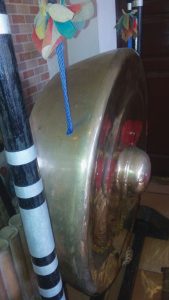What is characteristic about Balinese gongs?


The two common types of materials for gong making are bronze and iron, with the former being more prestigious and therefore a lot more expensive. Although there are a number of iron gong makers in Bali, since the early 1980s, no bronze gongs larger than around 40 cm have been made here. Now all new Balinese gongs are imported from Java. Balinese tell me that the reason why Balinese no longer make large gongs is an economic one since it takes 10 workers to forge one large gong and the salaries in Bali are considerably higher than those in Java.
When looking at differences between Balinese gongs and others in Indonesia (for the purpose of this article I’m going to focus on the island with the largest gong production, which is Java), I’m going to look at only on hanging gongs with bosses.
The common shape of a Balinese gong is a little different from a Javanese one and this is particularly noticeable in the boss region where a Balinese boss is less pronounced (you see this feature in West Javanese gongs too so sometimes it can be hard to tell the difference). Both original Balinese and Sundanese gongs have less depth in the body of them. All of this is connected to the sound: in Bali a quick wave vibration is preferred whereas typically in Java the vibration is slow and rounded. This reflects the speed of the music and also the way the gongs are used. In Javanese music, where the gong is played at the end of the piece, the rest of the ensemble finishes first (on time) and the gong plays just slightly afterwards: here the gong is suited to be slower and very deep. In Bali, the opposite is true: gongs are played exactly on the beat, and often in quick succession so, with the exception of one or two ensembles, gongs are never very deep: certainly not like the largest ones needed for Javanese music.
The larger the gong, the lower the sound: the largest type of Javanese gong (referred to as ‘gong ageng’ meaning big gong) is more than a metre in diameter, whereas in Bali the largest I’ve seen used is 83-85 centimetres (referred to as ‘gong wadon’ meaning female gong).
The sound of a gong is very important to a Balinese, both sonically and magically – I’ll explain this in my next edition of Kulture Kid.
Copyright © Kulture Kid 2018
You can read all past articles of Kulture Kid at www.BaliAdvertiser.biz